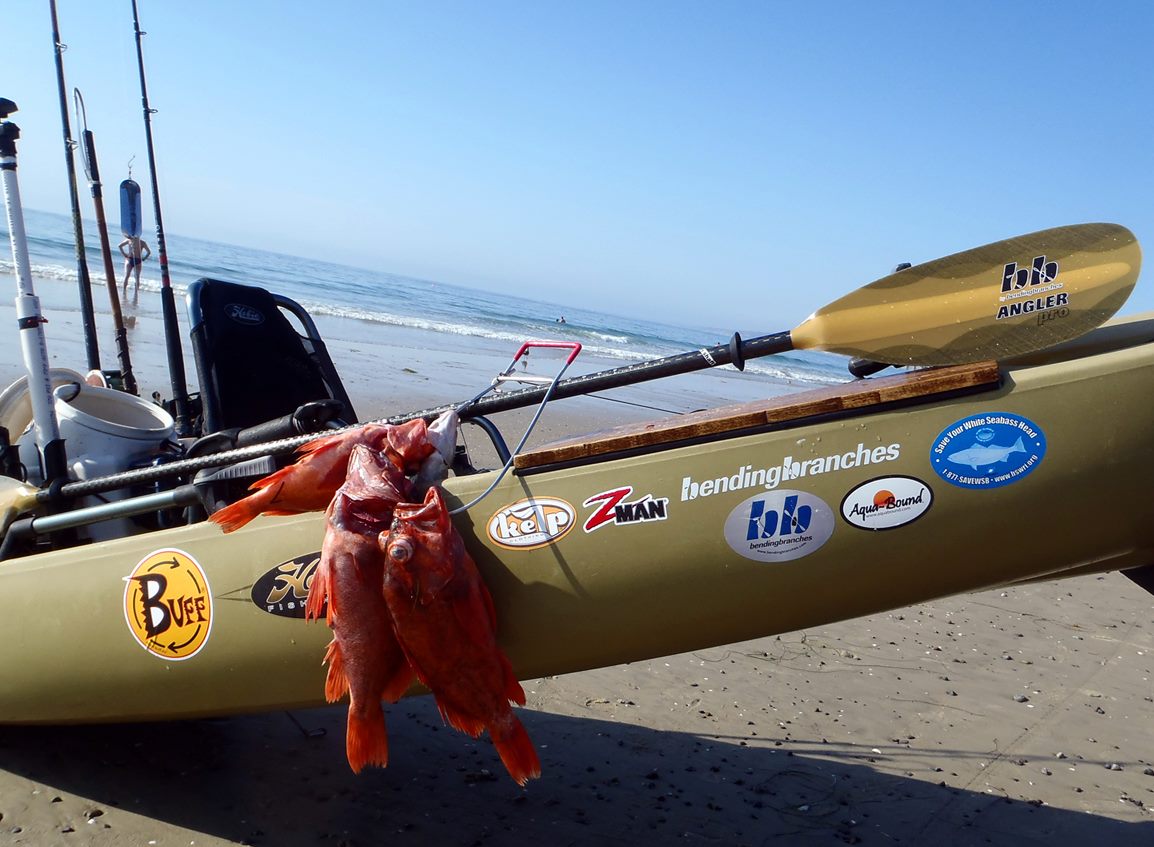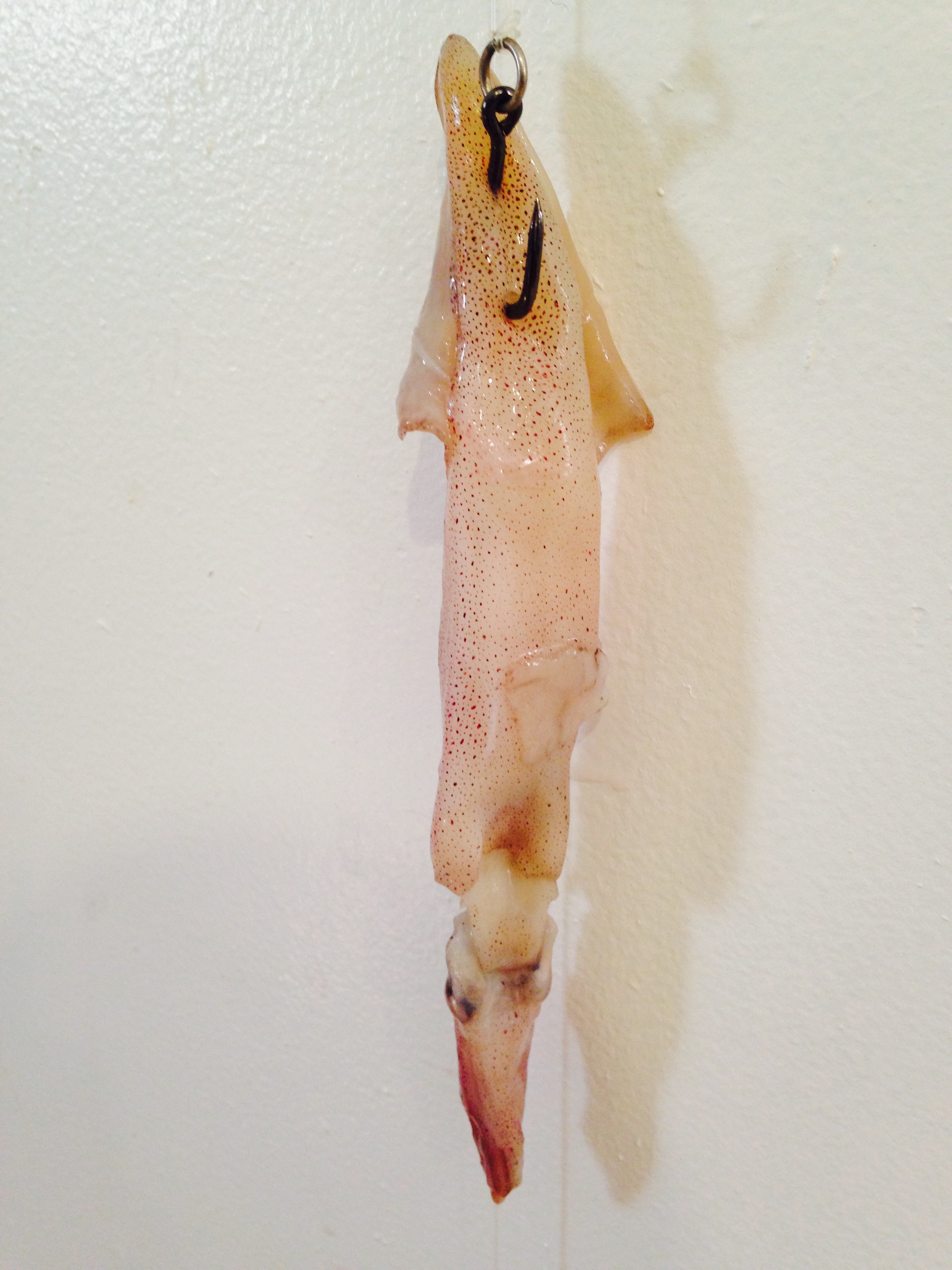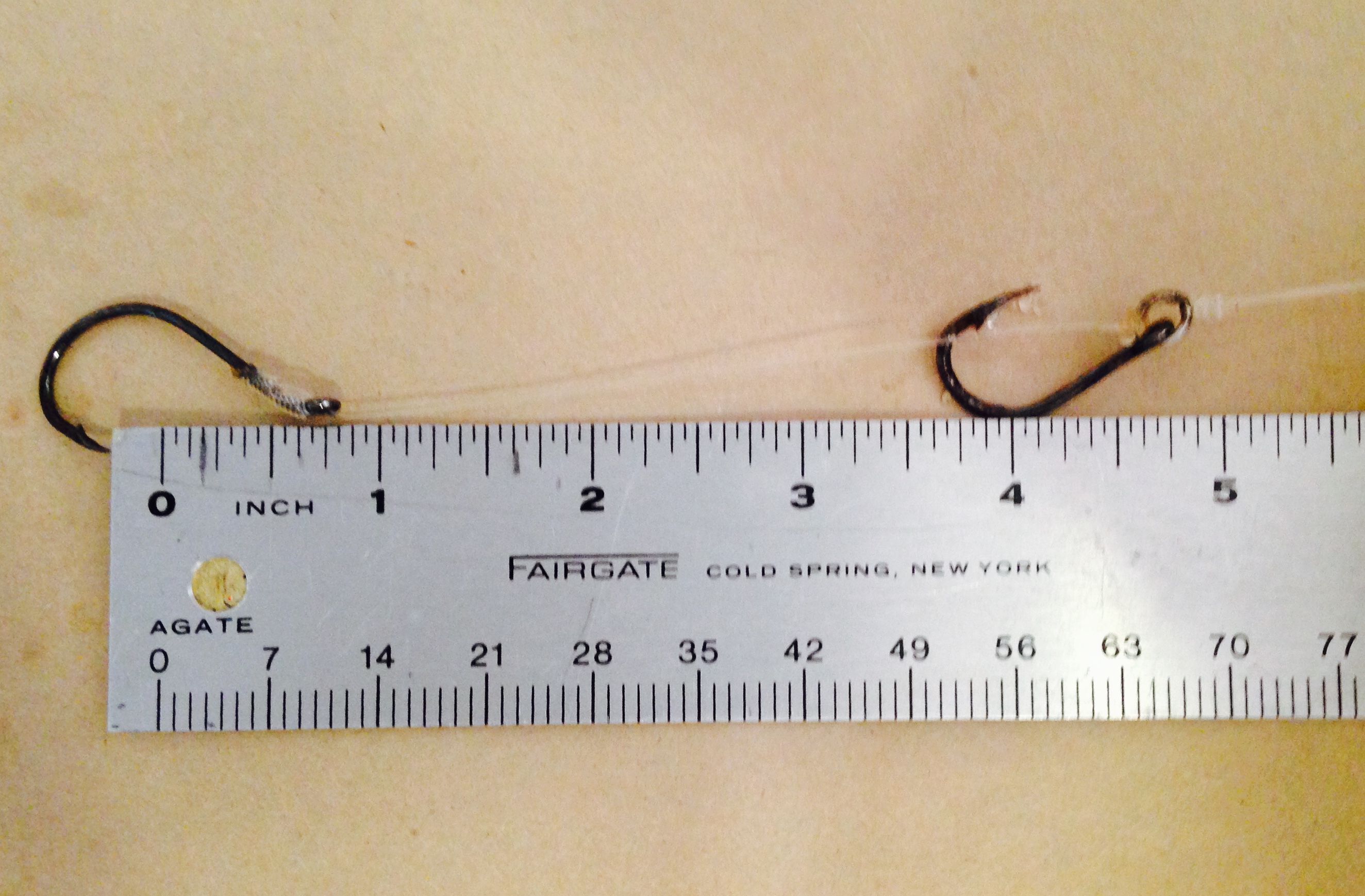Rockin
by Wade Harness / Guide @ Captain Wade Charters / www.captainwade.com
Anyone can go out tomorrow and pull up a few dink reds with a #101 mono set up. This below however, is a short Rockfish refinement #210 overview, specifically for the Hobie MirageDrive kayak anglers. I’ve personally paddled a traditional kayak for over two decades, & a paddler can “attempt” this feat, but it is really imperative to have a MirageDrive & a hand operated rudder control while working in deep water applications. Once a small mark presents itself on your sonar screen, instantly deploy one’s rock rig while staying on the mark in a stiff current.
(Big marks, large schools are easy to identify, so for all intensive purposes, we will discuss less than optimal conditions coupled with minimal sonar returns for still being productive.
If you have a paddle in your hands, I’m sorry but you are already too late for this fiesta. (This is a taco party!) Your hands needed to be holding a rod & reel, with your eyes monitoring your chartplotter and/or sonar for a light peppering across the bottom of your sonar screen, or in the least, a small mark barely hovering over or under a pinnacle/transitional section & again quickly drop your rig in place, with no haste! You will now either have to turn HARD right, or HARD left while peddling swiftly to turn around. (Similar techique to dropping anchor on a set spot/mark & accounting for fall while cutting back.) Once you round the 90 degree mark (while still in free spool), you will begin to get above your dropping line and get vertical around it again. This is exactly where you want to be & not at an angle. You may need to begin slightly thumbing your spool at this stage, to slow down your spools decent rate if in a ripping current. If your line is at an angle, you are letting your line out too fast, or the current is too strong before getting back around to your original heading. Once @ 180+ degrees you should be straight up and down, above your rig ready to touch the bottom, with no slack upon instant contact, and then reel it up (1) crank up off the seafloor. Be ready for bendo. Keep a light peddle to stay precisely on target mark/structure/waypoint & in current, as to not loose ground. Try & point rudder/bow into any headwind, and account for current, drift & winds, while anticipating the quick grab from large rockfish at any moment. React fast to get a solid hookset. These fish are very adapt at stripping you clean before you can even react. One 5# box of white squid, not pink or purple, is more than sufficient to get the job done. Anything more & your feeding the fish, & not paying attention.
This week Commercial lobster buoys will be in place one again, not only giving you a visual indicator of the local reef lines, but it also provides a chum source if they recently baited.
If quality goats are on your target list, this is one tried & true kayak productive method. You don’t have to be right on top of the trap line either, as you don’t want to break off, and one needs ample room to pull toads off of any structure when the freight train tuggers begin their defense. Anything within a reef dwellers peripheral vision & he is going to scream down and wrap around if given the opportunity. Remember to mark these productive areas, as their traps are rotated often. On the flip side of that coin, it unfortuantly puts up an obstacle course in perfect timing for our local homeguard winter action. (FYI- The commercial traps owners & the CA DFW do not like you to even touch or disturb their lines/gear, & rightfully so because it’s the law. )
When ‘Rockin’ deep, you can never be certain your hook is still baited after its been down there for awhile. This is why it is important to always have at least one of your hooks with an artificial set-up. I.E. Tried & true bucktail jigs, Double-Dropper loops with an artificial above & a live/fresh dead offering below/chumming. Smaller nibblers on the bottom usually peck the head & tentacles off clean & quick, so keeping an artificial offering 24”+ above proves effective in heavy limits consistently. (Noted: Tentacles also the most inciting part of the squid)
(Be aware of your areas current regulations regarding use of more than one hook while targeting rockfish. Two hooks are common.) Winding up from 150’+ to check your line & rebating becomes tiresome especially in heavy current. This is why it’s important to peddle a Hobie MirageDrive kayak vs. a paddle kayak when targeting rockfish for table fair.
If the Yellowtail aren’t around & the refrigerator is empty, nothing can beat a loaded game clip soon destined for a taco feast fit for a King!

Productive swimbaits and Ling Cod killers include, and are not limited to, 5” Z-Man PaddlerZ, 6” SwimmerZ, 7” Scented Jerk ShadZ and 8” StreakZ XL are all great proven plastic baits to drop into the deep end. The super soft ElaZtech material withstands repeated attacks from toothy beasts like ling cod & goats. It’s buoyant material also floats up off the seafloor and away from the mainline to hold just off the bottom, presenting the dorsal upright every time looking extremely lifelike while keeping it directly in the bite zone. Ordinary non-buoyant plastics fall limp & lifeless around your line or to the ground. Size of dropper loops are very important, as you don’t want to tie some exaggerated 20”+ dog eared loop to tie off to. This will undoubtably lead to a fouled main line. Less time rebating, untangling, and more time throwing ‘em on the game clip.
Top / Left to Right:
5” Z-Man PaddlerZ Sexy Mullet EWG • Coconut Ice 5” PaddlerZ / 7/0 EWG
6” SwimmerZ Bad Shad • 6” SwimmerZ Opening Night Heavy Gauge 8/0 EWG
StreakZ XL Pearl • StreakZ XL Baby Bass / Heavy Gauge 8/0 EWG
7” Scented Jerk ShadZ in Nuked Pilchard Glow (L) / 7” Scented Jerk ShadZ in Bubble Gum (R) Heavy Gauge 8/0 EWG
6” SwimmerZ in Sexy Mullet +SwimJig in matching Chartreuse skirted weedless swimjig.
6” SwimmerZ in Sexy Mullet + pearl market squid skirt weedless swimjig.

Sure you can get-by & use the plastics that are currently in your tackle-box in the garage, but the same point I am trying to make about live bait offerings losing their appeal, this equally applies to regular plastic swimbaits getting short bit, as well as the swimming action, look, feel & overall buoyancy. Z-Man fish better because they catch 10X more fish per bait and almost the entire Z-Man lineup is ProCure impregnated. (They also cost less than whats in your current arsenal.) After 1-2 good hits or a few missed strikes when fishing over +150’ deep, its a pain to keep winding up leaving the traveling schools to roam elsewhere in the current while you constantly recheck & rebait. Losing the main attraction aka “head & tentacles” of your squid, is the same as losing your big boot paddletail on your swimmy. It looks boring, & chances are it will get overlooked plain & simple. The advantage using ElaZtech over using live or fresh dead bait when rockfishing, is when you do get slammed while fishing that deep , your top hook will still be rigged with its paddletail or jerk shad wiggling in the strike zone till you decide to rebait your lower live bait hook.
(Or bucktail jig, ect.) A softer durometer plastic bait translates to more than a longer lasting plastic bait against toothy critters. The softer ElaZtech material allows for more solid hook sets when rigged weedless, and you don’t have to precut belly slots, as Z-Man’s entire lineup has belly-slots and/or fin-slot protectors to help keep you truly weedless & their super soft space age plastic = incredibly lifelike action. Its frequent to deck rockfish that puke up small octopus & squids from encountering ‘the benz’, so most colorways I throw are in the Pearl range, Bubblegum, Nuked Pilchard Glow, Smokey Shad & Baby Bass to mimic the finbait forage too. Guaranteed solid Southern California rockfish limits can easily be had across our coastline with just a couple proper kayak rigs. Most paddle kayakers get discouraged on account of the current by constantly trying to stay on top of their mark & getting blown all around. This simple feat is achieved by lightly peddling your MirageDrive over your mark, with rod in hand in wait. Spectra line is an absolute must while kayak rockfishing. NO mono except for a short 3-4’ leader (I.E.: From the Spectra is allowed for this productive recipe.) Fishing that deep, you need instant hook sets and no stretch, no slack. Go ahead and fish your mono, and chances are the good ones will shake you off and strip you before you can ever set the hook. 30-40# Fluorocarbon isn’t necessary on rockfish rigs for its invisibility properties, but for its abrasion resistance on account of getting chafed being only 1 crank off the bottom.
Below are 3 sonar images. One at regular view,.

One @ 1X Zoom, where even on a HDS system, you have to squint and look hard for any stippling or peppering on the bottom for structure holding fish. & the other @ 2X zoom. You will now begin to be able to discern some bottom definition than you saw in regular view/no zoom. (All three screenshots are taken at 12:19PM. ignore the +2’ differential in the 1X photo. This is the exact same spot, difference just equates to the rise & fall..) After 2X zoom is utilized, you will start to see the distortion really get exaggerated, thus the reason why I won’t be mentioning +3X zoom.

At 1-2X magnification you can see the bottom detail brought to your attention that isn’t discernible from the raw regular view. What you normally have been going over thinking was relatively flat, is actually transitional with plenty of structure holding more than “nooks and crannies”.

With todays high definition chart plotters, a sonar unit isn’t even necessary to find said structure. Shaded relief maps like Navionics, provide plenty of visual indicators of rubble piles, reefs, dimpled fish havens. Below is a view off the LJ kelp with more than a few productive piles. No sonar needed. just use your boats current cursor in position the same or one of those smartphone apps will even work amazing.

Dropper Loop Weights: 6-10 oz torpedos.
Shrimp, Even the raw frozen stuff from the grocery store can yield limits quick with its sweet smell drawing them all in to feast. Keep the shell on to keep them on your hook longer. Place shrimp half way down a J Hook, or thread them all the way down a longer shank J hook. Circle hooks are not necessary, as almost any fish you catch will end up on the gameclip.
Baiting squid. Twice through the end of the mantle. (Once first at the very end, 1/2” down, turn 180 & back through & in-between the middle fins.

For a combo presentation try pinning one more squid just once through the tip of the mantle over the first double pinned squid.

Short Stinger on a dropper loop, / ‘The Bacon Bringer’. First pin the ringed hook the same way double pinned at the end of the mantle. Run the short octopus hook stinger, through & out the end of the squids neck and into & out of the head. (The squids tentacles are the real attention grabber.) (Once the head is ripped off, its best to just save that lifeless “tube” for strips when you run out of squid at the end of the day. / Mental note # 24: Try and not set the hook on the pesky lil’ ones aka machine gunners..) Any basic snell or egg drop loop will suffice to make this simple effective rig.

Poorpedo: Painted 6-10 Oz torpedo on the bottom of your dropper loop, W/ J-hook or treble + a squid strip &/or swimbait trailer of choice. (Ripping current tip: Try placing a Knife jig or Butterfly jig to speed drop your offering to the bottom when current is really strong.)
Possibilities are really endless..Pull up a plate of tacos tonight!